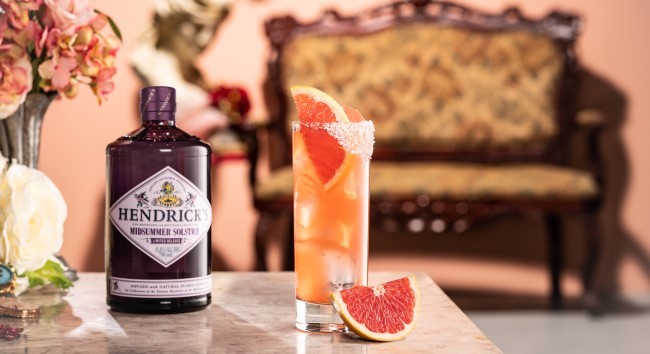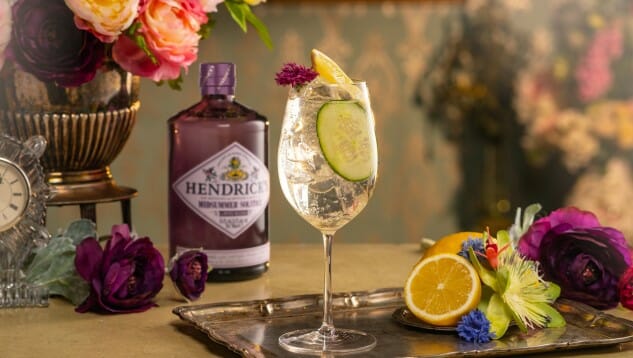As far as flavor descriptors go, “floral” is a particularly common adjective to see in the gin category … but a deceptively complicated one, at the same time. What does it truly mean to be “floral”? To evoke fresh flowers, certainly. But what does “floral” really taste like? After all, few of us stroll through the meadow, gnawing on just-plucked flower petals to understand how they taste. And how much more complicated do things become when we consider just how many species of flower exist? The smell of a rose isn’t the same as that of jasmine, or a gardenia. And yet all are “floral,” yes?
These are the sorts of ephemeral flavor mysteries pondered by one Lesley Gracie, the master distiller of Scotland-based Hendrick’s Gin. For the last two decades (Hendrick’s was first created in 1999), her claim to fame has been the brand’s flagship gin, which flipped the script in a world of classical London dry gins through the novel inclusion of iconic (but underutilized) symbols of the UK: Cucumbers and roses. But in the wake of opening the brand’s stately new “Gin Palace” and expanded distillery in Girvan, Scotland, Gracie’s attention has turned in new directions. With more distilling capacity than ever, she’s been free to travel further down the road hinted at by the presence of rose essence in the original Hendrick’s Gin. The eventual destination? Midsummer Solstice, a celebration of everything “floral,” and then some. The company describes Midsummer Solstice as capturing the essence of the “aromatic intensity of a midsummer day.”
“I have always been enamored by the power of nature’s flavors and aromas at the peak of summer, and for this new expression I’ve hand-selected each floral essence to capture this intensity,” said Gracie, in the brand’s announcement of Midsummer Solstice. “It joins a long line of innovations from Hendrick’s and I’m excited to not only create new expressions at the Gin Palace, but also share them with curious tasters and gin explorers all over the world.”
During a recent press visit to tour the beautiful Gin Palace, I had an opportunity to get more acquainted with several varieties of Hendrick’s within the context of tasting alongside Gracie—an honor that most gin drinkers will unfortunately never get a chance to experience. Suffice to say, tasting gin beside a master of the craft can’t help but offer a deeper understanding of the spirit’s subtleties. For me, it helped me draw clear lines between the character of standard Hendrick’s Gin and what makes Midsummer Solstice unique.

Hendrick’s Midsummer Solstice Gin Tasting
My initial taste of Midsummer Solstice was neat, which proved to be both illuminating and potentially deceptive. Although this tasting made a strong showing of some of Midsummer’s most unique aspects, it left me surprised for a second time when I later sampled the gin within the context of mixed drinks and cocktails.
Sampled neat, Midsummer is very pleasant and easygoing on the nose. My notes use a term I may or may not have just invented, “bloomy,” to describe the impression of a bunch of wildflower notes acting at once, like you’re downwind of a field full of pollinators. It smells like an orchard—sweet orange and heady aromas abound.
On the palate, however, I registered my first surprise: This is a distinctly fruity and sweet gin, when tasting neat. It lights up the tongue’s receptors with impressions of sweet red berries—strawberry and raspberry in particular—in a way I’ve never really experienced before in gin. It presents as noticeably sweeter than the base expression of Hendrick’s, with an initial rush of heat and fruit, like SweeTarts candy and strawberry jam, notes that will no doubt make it extremely accessible to the average drinker, or those who find most gins too dry or bitter. Indeed, this feels very much calculated to be a crowd pleaser, and my ultimate impression was less of “florals” and more of “a delightfully fruity little sponge cake you would eat during high tea.”
Imagine my surprise, then, when I later sampled a Midsummer Solstice and tonic, only to find that my initial assessment had changed substantially. This proves to be the magic of Midsummer—it undergoes some kind of change, within the context of cocktails and mixed drinks. The sweetness and berry fruitiness are still there, but they’ve been filed down and smoothed out, and their lower assertiveness level suddenly allows the more overtly floral notes to come out and shine. Suddenly, thanks to the balancing bitterness and quinine notes you find in your tonic, I’m getting delicate floral notes of violet, hibiscus and rose hips on the nose of this drink. It really is an impressive transformation, and I can’t help but think it’s probably exactly what Master Distiller Lesley Gracie intended. As a chemist (and an artist), she seems to possess the ability to focus intently on the bigger picture of her products, considering how they should present to the drinker not only on their own, but as a cocktail component.
“To me, it’s like when you get a bouquet of flowers,” she said at Gin Palace, in reference to Midsummer. “It’s not about the individual flowers; it’s about the effect of the whole bouquet. I don’t like to talk about specific floral notes, because I’d rather it be appreciated as a whole, rather than searching for specific parts.”
The unique profile of Midsummer Solstice is thrown into even sharper relief via comparison with the brand’s first major flavor experiment, Orbium, which was first released in the U.S. in December of 2018. This “quininated” gin was infused with quinine, wormwood and blue lotus blossom, creating a more bitter, sophisticated, mysterious gin seemingly tailored for the amaro-drinkers and amateur mixologists in the house. You could think of the two special releases as ideological balancing points: Orbium on one side of a spectrum, appealing to the spirits geeks, classic Hendrick’s in the middle, and Midsummer Solstice on the opposite end, with more obvious mass appeal in its profile. Together, the three form a perfect triptych.
U.S. consumers will get their own chance to sample Midsummer Solstice as bottles begin to appear in cocktail bars and on store shelves in the immediate future. As summer begins to bloom and the mercury rises in our thermometers, there’s never been a better time to stock up on tonic and reconsider exactly what “floral” means to you.
Jim Vorel is a Paste staff writer and resident liquor geek. You can follow him on Twitter for more drink writing.

